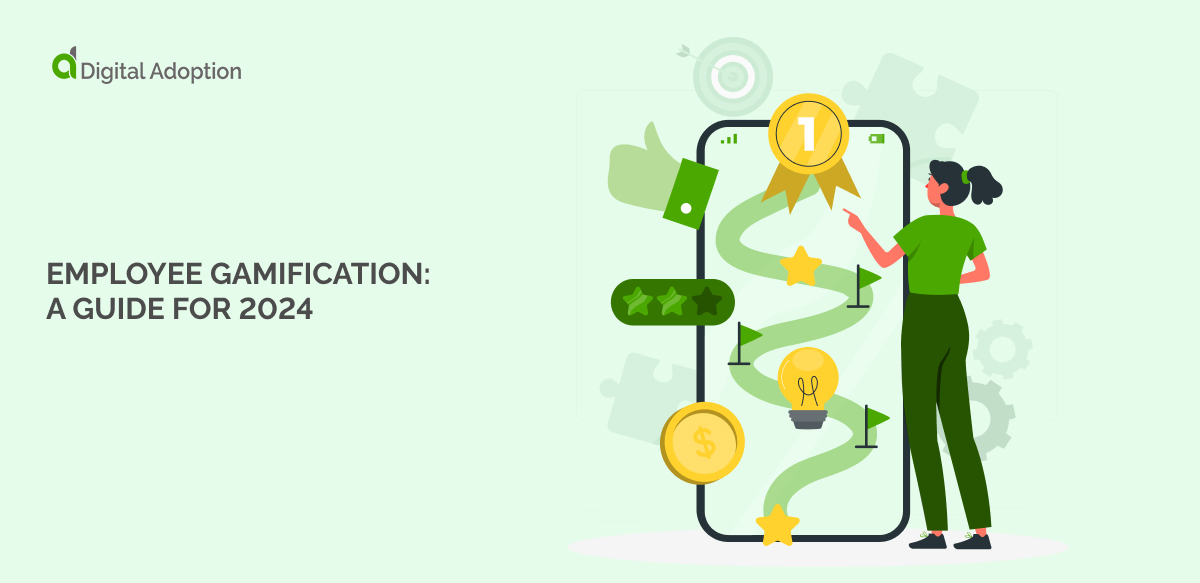Business leaders have been getting excited about customer gamification for a good long while. In a world where margins are more challenging than ever, gamification can inspire deep customer loyalty that brings huge returns.
Following the success of customer-based gamification, leaders are turning to game-based elements to improve employee motivation. In the fast-paced race to get the most engaged employees possible, many different forms of gaming are helping businesses deliver on their goals.
From user onboarding to business process improvement and much more, gamification techniques can play a valuable role in your company. This article will discuss the following:
- What employee gamification is and how it works.
- The major benefits of employee gamification and the risks.
- Important examples of employee gamification to inspire your own work.
What is Employee Gamification?
Definition
Employee Gamification is an innovative workplace strategy that applies game-design elements and principles in non-game contexts to improve employee engagement, productivity, learning, and job satisfaction. At its core, it involves integrating game mechanics such as points, levels, challenges, rewards, and leaderboards into work-related tasks and processes.
Gamification has long been a familiar part of business life. Quirky performance bonuses, leaderboards, and Christmas jumper competitions are all examples of long-standing workplace gamification. However, in 2024, gamification has entered its digital age. Leaders can easily use cutting-edge software to introduce gamified processes to every part of their business.
The purpose of employee gamification
The purpose of gamification is linked to fundamental company goals. For example, to promote loyalty, boost employee engagement and motivation, improve outcomes, and enhance training.
Gamification can be especially effective in areas of work that are perceived as boring or unimportant – like compliance matters or health and safety training. However, employee gamification can play an important role in any aspect of performance management, training, or general engagement programs.
The impact of gamification
People take different perspectives on the value and impact of employee gamification.
On the one hand, some detractors call gamification a gimmick. They say that the whole gamification concept is just a way to make employees forget how awful work is.
However, in many situations, gamification programs contribute very effectively to working outcomes. A 2023 article from the UK’s HR magazine gives an example from the insurance platform YuLife, where leaderboards and challenges can encourage them to walk up to 35% more in their daily routine.
To help explain the impact of employee gamification, the following two sections will examine some of the key benefits and risks associated with gamification.
The Benefits of Employee Gamification
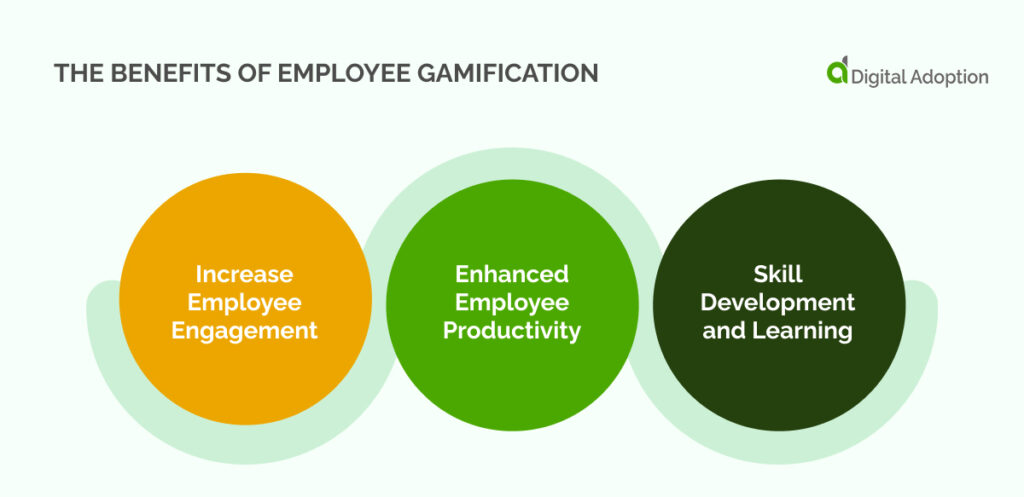
There are many ways to gamify a workplace, and there are many ways to benefit from the process. Out of the many benefits, we’ve chosen to focus on three key gains: increasing engagement, enhancing productivity, and raising standards in training.
Whether you’re trying to employee digital engagement for one particular application or area of your business, to complement your employee training software provision. or simply to enhance your all-round company culture, these techniques will help you on your way.
Increase Employee Engagement
Gamification is often a powerful tool to increase employee engagement by introducing elements of competition, recognition, and rewards. When employees participate in game-like activities, they feel a heightened sense of motivation and achievement.
The interactive nature of gamification fosters a dynamic work environment where individuals are not only focused on their tasks but are also driven to outperform their peers. This heightened engagement translates into improved productivity, a positive workplace culture, better employee morale, and a wide sense of fulfillment among employees.
Enhanced Employee Productivity
The incorporation of game-like features, such as points, leaderboards, and challenges, stimulates healthy competition among employees. This competition paves the way for increased employee productivity as individuals strive to achieve and surpass set targets.
The gamified approach makes work more enjoyable but instills a continuous improvement mindset. Employees are motivated not just to meet expectations but to consistently excel, contributing to a more efficient and effective workforce.
Skill Development and Learning
Gamification provides a dynamic platform for skill development and continuous learning within the workplace. By integrating game mechanics into training programs or day-to-day tasks, employees engage in interactive experiences that facilitate the acquisition of new skills and knowledge.
The gamified approach not only makes learning more enjoyable but also encourages employees to proactively seek opportunities for professional development. This results in a workforce that is not only proficient in their current roles but also adaptable to evolving challenges and responsibilities.
The Risks of Employee Gamification
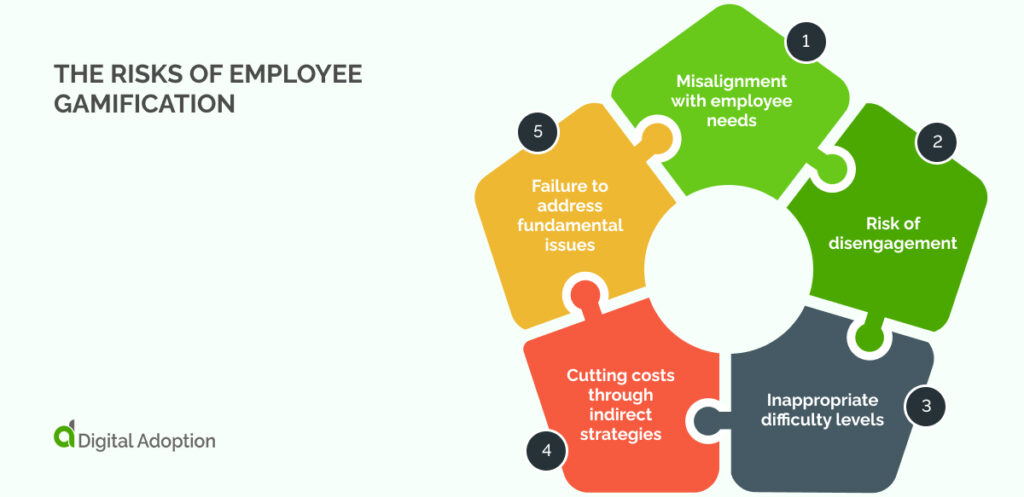
There is no doubt that employee gamification has had a huge impact on the world of work. But there are plenty of people out there who question the value of gamification.
So before you put time and money into a gamification program, think about these risks.
Misalignment with employee needs
When gamification strategies are not tailored to align with the unique attributes, motivators, and job roles of employees, it can lead to a lack of engagement. One-size-fits-all approaches may fail to address the diverse needs of a workforce, resulting in decreased enthusiasm and participation.
Risk of disengagement
Poorly designed gamification solutions have the potential to backfire, causing disengagement among employees. If the game doesn’t resonate with the workers or feels insincere, it may lead to a negative perception of management’s intentions, ultimately harming the work environment.
Inappropriate difficulty levels
Setting missions that are either too easy or too hard can significantly impact the success of a gamification program. If tasks are too easy, employees may lose interest due to lack of challenge, while overly difficult missions can create anxiety and frustration, leading to a decline in morale and participation.
Cutting costs through indirect strategies
Some companies may misuse gamification as a tool to indirectly reduce wages or bonuses, exploiting the enthusiasm of employees for cost-cutting purposes. This can result in strained employer-employee relationships and a negative impact on overall job satisfaction.
Failure to address fundamental issues
Gamification, if not accompanied by meaningful changes to address the fundamental aspects of work, may only serve as a superficial distraction. If the underlying issues of a job, such as its repetitive or monotonous nature, are not addressed, employees may experience sustained dissatisfaction and decreased motivation.
Great Examples of Employee Gamification
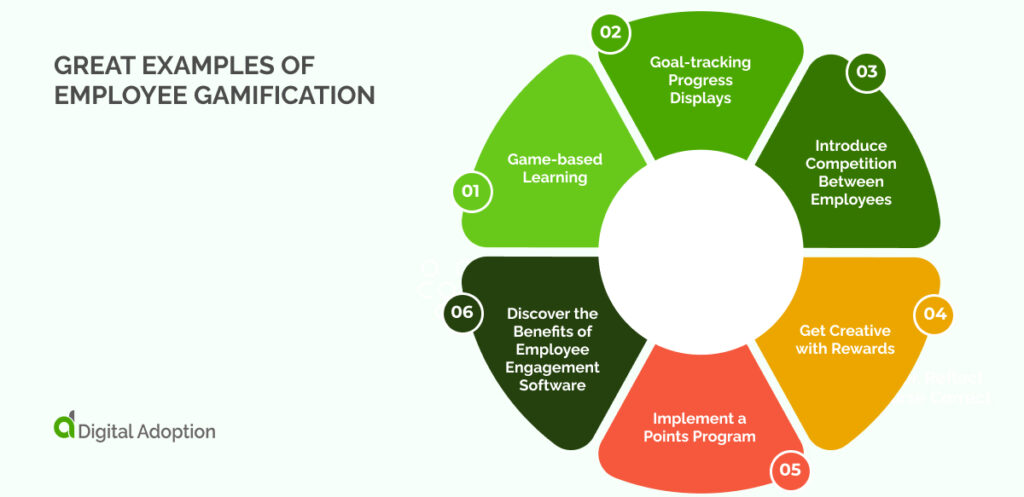
There are infinite ways of gamifying your employees’ work experience! the sky’s the limit, and can use some element of trial and error to discover the techniques that work most effectively for your employees. To get you started, here are five examples that are especially important.
Game-based Learning
Transforming employee training into interactive games can revolutionize the learning experience. Incorporate elements like trivia, quizzes, and competitive challenges to make training sessions more engaging and enjoyable. By adding a gamified layer to learning, employees are more likely to retain information, fostering a dynamic and effective approach to skill development.
Goal-tracking Progress Displays
Visualizing progress toward goals is a powerful motivator for employees. Utilize progress bars or visual displays that showcase individual or team achievements. This not only provides a clear sense of accomplishment but also acts as a constant reminder of the targets ahead, driving employees to stay focused and motivated in their pursuit of success.
Introduce Competition Between Employees
Foster a spirit of healthy competition among employees, especially in sales teams where setting and achieving targets is crucial. Implement a system that allows individuals or teams to compete against each other, with progress prominently displayed. This not only encourages friendly rivalry but also boosts overall productivity and performance as employees strive to outdo one another in a constructive manner.
Get Creative with Rewards
Rewarding achievements doesn’t have to break the bank. Get creative with low-cost incentives that make a big impact. Consider offering badges prominently featured on company correspondence, extra breaks, the flexibility to set schedules, or even a complimentary lunch courtesy of the company. These creative rewards add a personal touch to recognition, enhancing the overall employee experience.
Implement a Points Program
Developing employee points reward programs adds an element of fun and motivation to the workplace. Allow employees to earn points for various achievements and activities. These points can be redeemed for small prizes, creating immediate gratification, or saved up for more substantial rewards like gift cards or a well-deserved day off with pay.
Align the rewards offered with the preferences of your staff to ensure maximum engagement and satisfaction.
Discover the Benefits of Employee Engagement Software
Appropriate software can support your gamification journey very effectively. The right software tools help you customize challenges, run leaderboards in real-time leaderboards, and automate point systems.
From the employer’s side, Robust analytics tools track employee progress, and in-app communication enhances social interaction. In summary, gamification software serves as a multifaceted tool for motivating employees and aligning with broader business objectives.
Boost engagement and productivity with employee gamification
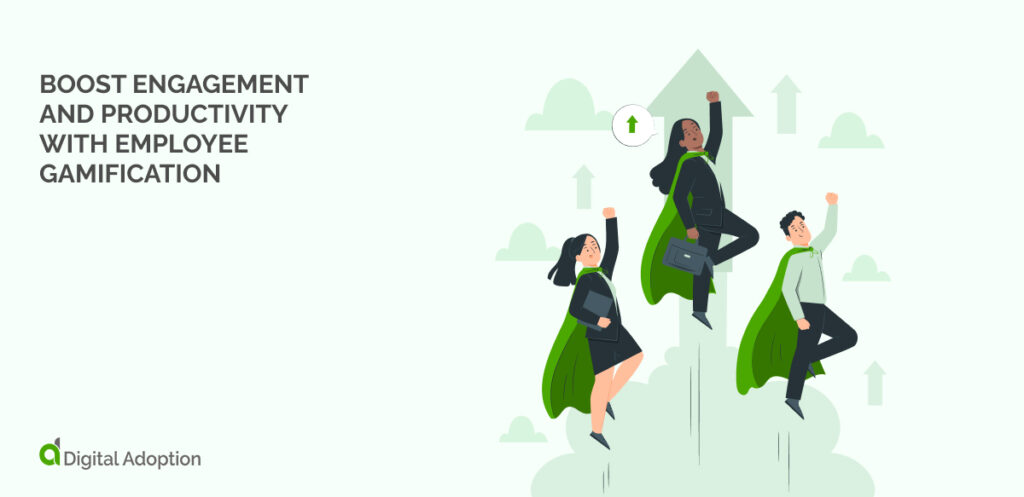
In the past, incentives were often only linked to the most cut-throat business areas. Think of the sales team of Glengarry Glen Ross, desperately aspiring to win a Cadillac, and desperately avoid being fired.
Today, gamification is in a new and exciting phase. The gamification of 2024 is not about make-or-break targets. Instead, it’s about encouraging a pattern of behavior that will make for gradual improvements and long-term success. And employees seem to agree that it works. Research published in 2021 suggested the vast majority of US workers surveyed (89%) felt that gamification could increase employee productivity.
The digital world has certainly moved on a little bit since then, but the opportunities for a gamification strategy are still strong. Whether you’re trying to motivate employees, reduce employee turnover, or improve company culture, gamification is a low-cost strategy.

